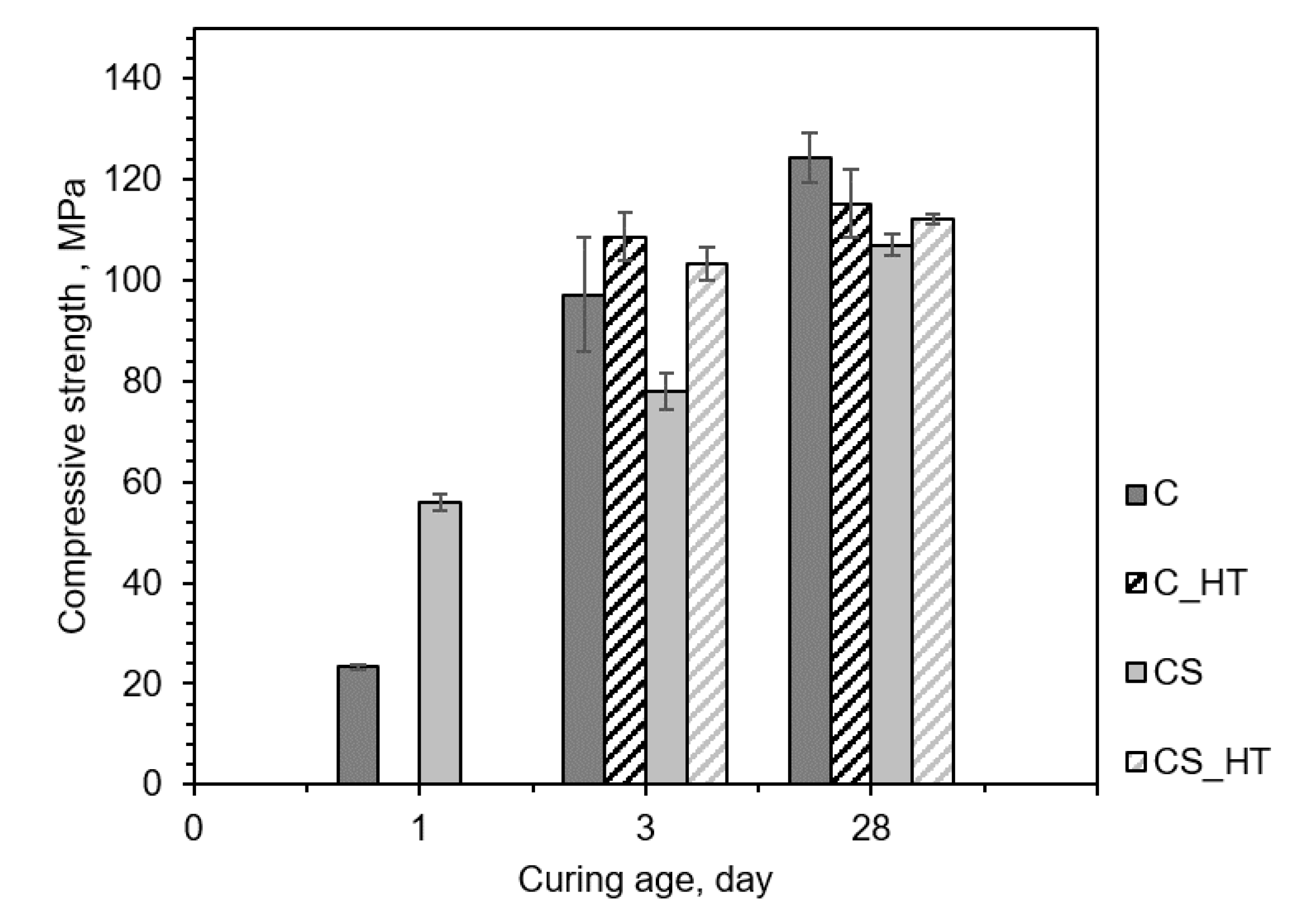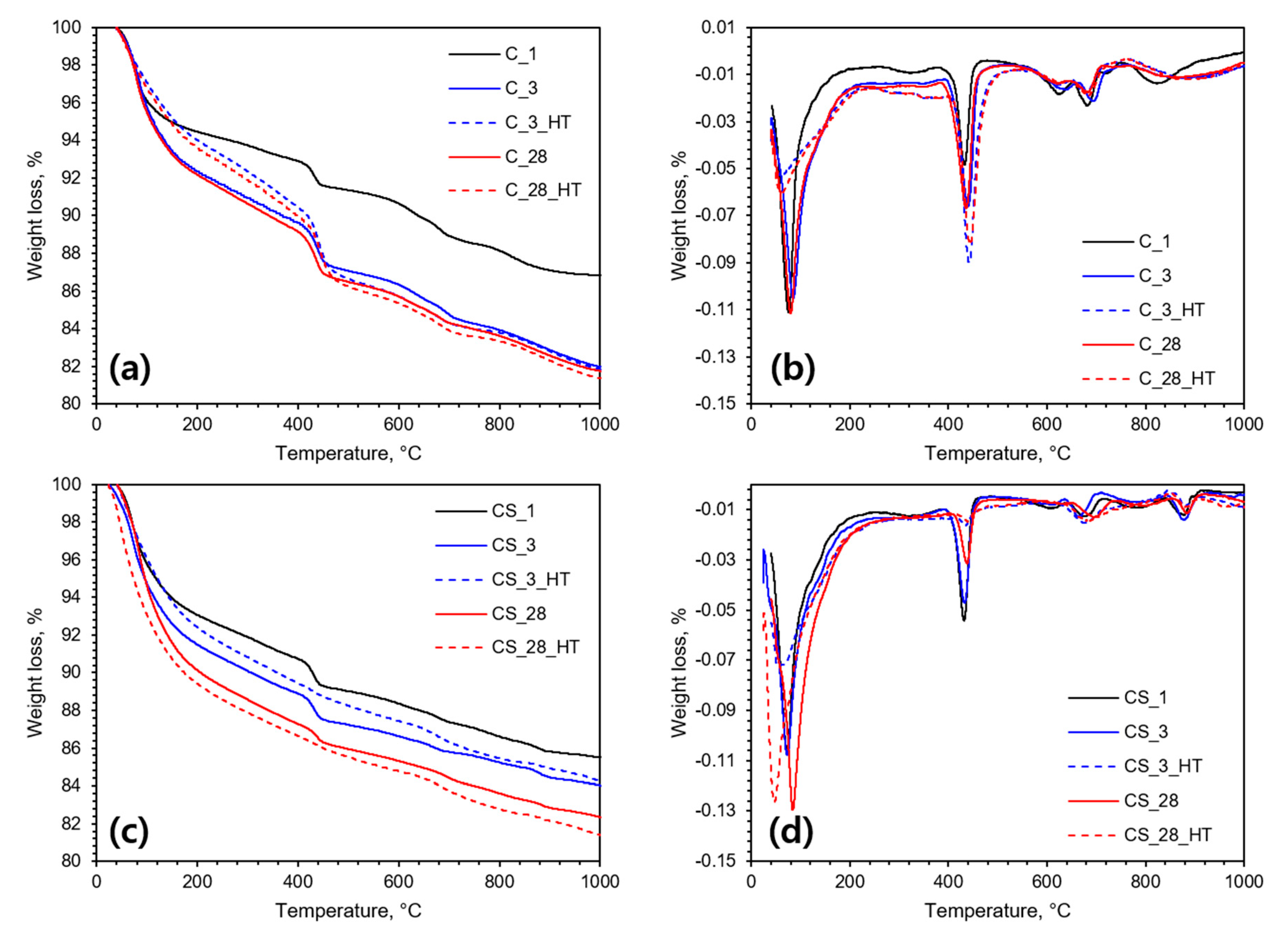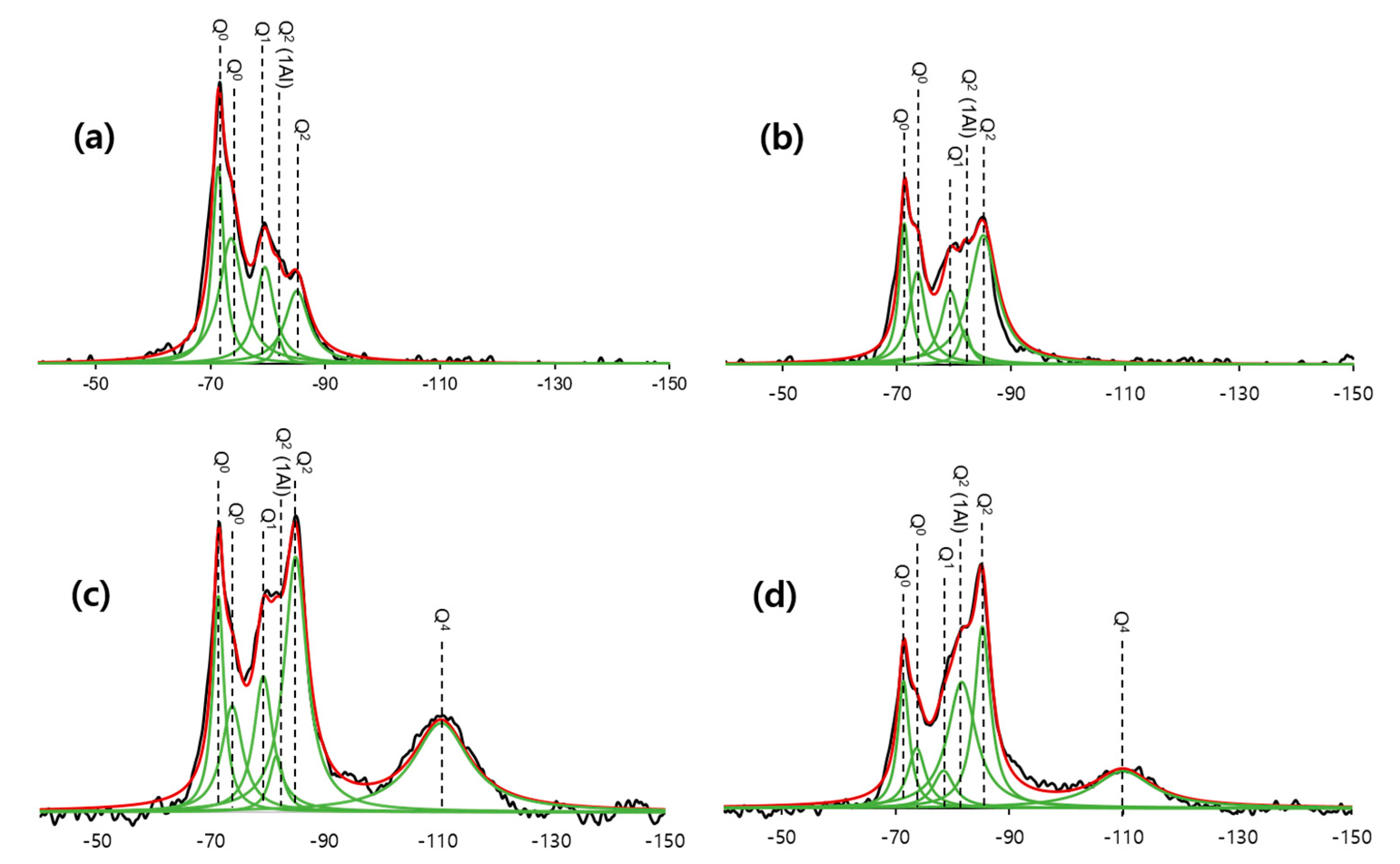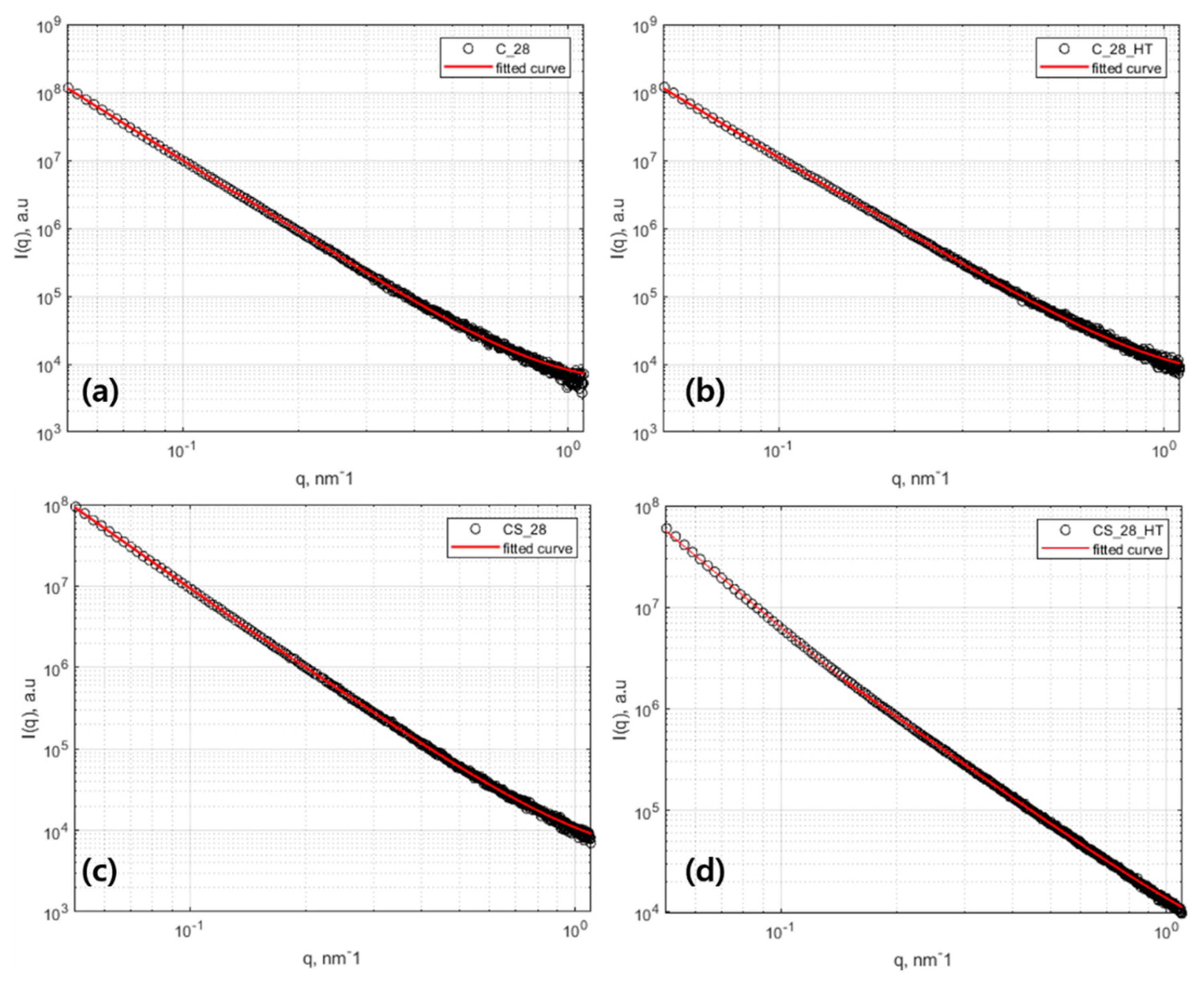Heat-Induced Acceleration of Pozzolanic Reaction Under Restrained Conditions and Consequent Structural Modification
Abstract
:1. Introduction
2. Materials and Experimental Details
2.1. Sample Preparation
2.2. Experimental Details
3. Experimental Results
3.1. Compressive Strength Development
3.2. XRD and TGA Results
3.3. 29Si MAS NMR Result
3.4. SAXS Results
4. Discussion
4.1. Cement Hydration Under Low Water Amount and High Temperature
4.2. Pozzolanic Reaction Under a Low Amount of Water and High Temperature
5. Conclusions
- In the initial curing stage, the silica-fume-added specimen showed a greater compressive strength because of the physical filler effect of silica fume. For 3 days of curing, cement hydration showed to be more dominant without high-temperature curing. With high-temperature curing, the pozzolanic reaction was more easily accelerated in enhancing the compressive strength. However, with 28 days of curing, the high-temperature-cured specimens showed negligible strength development because it diminished the opportunity of increasing the long-term compressive strength through rapid consumption of the given low amount of water.
- Quantitative and qualitative XRD analyses confirmed that high-temperature curing showed higher portlandite formation than at ambient temperature curing. High-temperature curing produces more portlandite crystals because high temperature enhanced the reactivity of clinker minerals. On the other hand, when silica fume was substituted with 20% of cement, the pozzolanic reaction was more easily accelerated compared to the acceleration degree of cement hydration. Negligible amounts of portlandite were found after the high temperature curing as a result of pozzolanic reaction. The reason was suggested by the readily accessible ingredients of the pozzolanic reaction (i.e., silica fume, water, portlandite) in a restrained environment and less dependency of water diffusion for activating the pozzolanic reaction. This suggestion was reinforced by the result of SAXS analysis.
- The 29Si MAS NMR experiment was performed to investigate the silicate chain of C–S–H. High-temperature curing resulted in an increase of the Q2 peaks, which is the inner part of the silicate chain, and a decrease of the Q1 peak, which is the edge peak. As silica fume particles participated in the pozzolanic reaction and in forming the additional C–S–H on the existing C–S–H particles, the increased rate of MCL under high-temperature curing was larger than in the non-added specimens. The existence of Q4 peak at 28 days indicated that the pozzolanic reaction was terminated due to the full consumption of water or portlandite during the heat treatment.
- Structural changes in the meso-scale were investigated with SAXS. With a high-temperature curing, the fractal dimension increased with enhanced cement hydration. The higher reaction degree of the clinker minerals made the surface of the C–S–H globule complicated and enlarged the size of the globule. On the other hand, because of the consumption of water by rapid hydration reaction under heat treatment, the internal structure of the composite became simpler, making the mass fractal dimension smaller. The pozzolanic reaction led to higher mass and surface fractal values, indicating that the pozzolanic reaction can be more easily accelerated under high temperature curing conditions. This can be explained by the fact that the pozzolanic reaction does not require the anhydrous as a reaction precursor. It consumes the hydration product of portlandite which will be more readily available on the surface of preproduced C–S–H where more water should be available for subsequent reactions. Therefore, the reaction does not require the diffusion mechanism of water for more crystal growth or further hydration. Therefore, the effect of the acceleration of the pozzolanic reaction under high temperature is more dominant in the low w/c environment.
Author Contributions
Funding
Acknowledgments
Conflicts of Interest
References
- Kang, S.-H.; Hong, S.-G.; Moon, J. The use of rice husk ash as reactive filler in ultra-high performance concrete. Cem. Concr. Res. 2019, 115, 389–400. [Google Scholar] [CrossRef]
- Kang, S.-H.; Jeong, Y.; Tan, K.H.; Moon, J. The use of limestone to replace physical filler of quartz powder in UHPFRC. Cem. Concr. Comp. 2018, 94, 238–247. [Google Scholar] [CrossRef]
- Kang, S.-H.; Lee, J.-H.; Hong, S.-G.; Moon, J. Microstructural Investigation of Heat-Treated Ultra-High Performance Concrete for Optimum Production. Materials 2017, 10, 1106. [Google Scholar] [CrossRef] [PubMed] [Green Version]
- Teichmann, T.; Schmidt, M. Influence of the packing density of fine particles on structure, strength and durability of UHPC. In Proceedings of the International Symposium on Ultra High Performance Concrete, Kassel, Germany, 5–7 March 2008; pp. 313–323. [Google Scholar]
- Oertel, T.; Helbig, U.; Hutter, F.; Kletti, H.; Sextl, G. Influence of amorphous silica on the hydration in ultra-high performance concrete. Cem. Concr. Res. 2014, 58, 121–130. [Google Scholar] [CrossRef]
- Weng, J.K.; Langan, B.; Ward, M. Pozzolanic reaction in Portland cement, silica fume, and fly ash mixtures. Can. J. Civ. Eng. 1997, 24, 754–760. [Google Scholar] [CrossRef]
- Yogendran, V.; Langan, B.W.; Ward, M.A. Hydration of cement and silica fume paste. Cem. Concr. Res. 1991, 21, 691–708. [Google Scholar] [CrossRef]
- Soroka, I.; Setter, N. The effect of fillers on strength of cement mortars. Cem. Concr. Res. 1977, 7, 449–456. [Google Scholar] [CrossRef]
- Shih, J.-Y.; Chang, T.-P.; Hsiao, T.-C. Effect of nanosilica on characterization of Portland cement composite. Mater. Sci. Eng. A 2006, 424, 266–274. [Google Scholar] [CrossRef]
- Shannag, M.J. High strength concrete containing natural pozzolan and silica fume. Cem. Concr. Comp. 2000, 22, 399–406. [Google Scholar] [CrossRef]
- Yogendran, V.; Langan, B.W.; Haque, M.N.; Ward, M.A. Silica Fume in High-Strength Concrete. ACI Mater. J. 1987, 84, 124–129. [Google Scholar]
- Cohen, M.D.; Olek, J.; Dolch, W.L. Mechanism of plastic shrinkage cracking in portland cement and portland cement-silica fume paste and mortar. Cem. Concr. Res. 1990, 20, 103–119. [Google Scholar] [CrossRef]
- Land, G.; Stephan, D. The influence of nano-silica on the hydration of ordinary Portland cement. J. Mater. Sci. 2012, 47, 1011–1017. [Google Scholar] [CrossRef]
- Shen, P.; Lu, L.; He, Y.; Rao, M.; Fu, Z.; Wang, F.; Hu, S. Experimental investigation on the autogenous shrinkage of steam cured ultra-high performance concrete. Constr. Build. Mater. 2018, 162, 512–522. [Google Scholar] [CrossRef]
- Yamato, T.; Emoto, Y.; Soeda, M. Strength and freezing-and-thawing resistance of concrete incorporating condensed silica fume. Spec. Publ. 1986, 91, 1095–1118. [Google Scholar]
- Kwon, Y.-H.; Kang, S.-H.; Hong, S.-G.; Moon, J. Intensified Pozzolanic Reaction on Kaolinite Clay-Based Mortar. Appl. Sci. 2017, 7, 522. [Google Scholar] [CrossRef] [Green Version]
- Astm, A. Standard test method for compressive strength of hydraulic cement mortars (using 2-in or [50-mm] cube specimens). Ann. Book ASTM Stand. 2013, 4, 1–9. [Google Scholar]
- Zhang, J.; Scherer, G.W. Comparison of methods for arresting hydration of cement. Cem. Concr. Res. 2011, 41, 1024–1036. [Google Scholar] [CrossRef]
- Snellings, R.; Chwast, J.; Cizer, Ö.; De Belie, N.; Dhandapani, Y.; Durdzinski, P.; Elsen, J.; Haufe, J.; Hooton, D.; Patapy, C.; et al. Report of TC 238-SCM: Hydration stoppage methods for phase assemblage studies of blended cements—results of a round robin test. Mater. Struct. 2018, 51, 111. [Google Scholar] [CrossRef]
- De La Torre, A.; Bruque, S.; Aranda, M. Rietveld quantitative amorphous content analysis. J. Appl. Crystallogr. 2001, 34, 196–202. [Google Scholar] [CrossRef]
- Zhang, Z.; Zhang, B.; Yan, P. Hydration and microstructures of concrete containing raw or densified silica fume at different curing temperatures. Constr. Build. Mater. 2016, 121, 483–490. [Google Scholar] [CrossRef]
- Zhang, M.-H.; Gjørv, O.E. Effect of silica fume on cement hydration in low porosity cement pastes. Cem. Concr. Res. 1991, 21, 800–808. [Google Scholar] [CrossRef]
- Schachinger, I.; Hilbig, H.; Stengel, T.; Fehling, E. Effect of curing temperature at an early age on the long-term strength development of UHPC. In Proceedings of the 2nd International Symposium on Ultra High Performance Concrete, Kassel, Germany, 2–5 June 2019; pp. 205–213. [Google Scholar]
- Heinz, D.; Urbonas, L.; Gerlicher, T. Effect of heat treatment method on the properties of UHPC. In Proceedings of the Hipermat 2012 3rd International Symposium on UHPC and Nanotechnology for High Performance Construction Materials, Kassel, Germany, 7–9 March 2012; pp. 283–290. [Google Scholar]
- Cheng-Yi, H.; Feldman, R.F. Influence of silica fume on the microstructural development in cement mortars. Cem. Concr. Res. 1985, 15, 285–294. [Google Scholar] [CrossRef] [Green Version]
- Lee, N.K.; Koh, K.T.; Kim, M.O.; Ryu, G.S. Uncovering the role of micro silica in hydration of ultra-high performance concrete (UHPC). Cem. Concr. Res. 2018, 104, 68–79. [Google Scholar] [CrossRef]
- Jeong, Y.; Hargis, C.; Kang, H.; Chun, S.-C.; Moon, J. The Effect of Elevated Curing Temperatures on High Ye’elimite Calcium Sulfoaluminate Cement Mortars. Materials 2019, 12, 1072. [Google Scholar] [CrossRef] [Green Version]
- Metz, K.R.; Lam, M.M.; Webb, A.G. Reference deconvolution: A simple and effective method for resolution enhancement in nuclear magnetic resonance spectroscopy. Concept. Magn. Reson. 2000, 12, 21–42. [Google Scholar] [CrossRef]
- Pena, P.; Rivas Mercury, J.M.; de Aza, A.H.; Turrillas, X.; Sobrados, I.; Sanz, J. Solid-state 27Al and 29Si NMR characterization of hydrates formed in calcium aluminate–silica fume mixtures. J. Solid State Chem. 2008, 181, 1744–1752. [Google Scholar] [CrossRef]
- Richardson, I.; Groves, G. The incorporation of minor and trace elements into calcium silicate hydrate (C–S–H) gel in hardened cement pastes. Cem. Concr. Res. 1993, 23, 131–138. [Google Scholar] [CrossRef]
- Wang, J.; Han, B.; Li, Z.; Yu, X.; Dong, X. Effect Investigation of Nanofillers on C–S–H Gel Structure with Si NMR. J. Mater. Civ. Eng. 2019, 31, 04018352. [Google Scholar] [CrossRef]
- Andersen, M.D.; Jakobsen, H.J.; Skibsted, J. Characterization of white Portland cement hydration and the C–S–H structure in the presence of sodium aluminate by 27Al and 29Si MAS NMR spectroscopy. Cem. Concr. Res. 2004, 34, 857–868. [Google Scholar] [CrossRef]
- Thomas, J.J.; Rothstein, D.; Jennings, H.M.; Christensen, B.J. Effect of hydration temperature on the solubility behavior of Ca-, S-, Al-, and Si-bearing solid phases in Portland cement pastes. Cem. Concr. Res. 2003, 33, 2037–2047. [Google Scholar] [CrossRef]
- Martínez-Ramírez, S.; Frías, M. The effect of curing temperature on white cement hydration. Constr. Build. Mater. 2009, 23, 1344–1348. [Google Scholar] [CrossRef] [Green Version]
- Allen, A.J.; Oberthur, R.C.; Pearson, D.; Schofield, P.; Wilding, C.R. Development of the fine porosity and gel structure of hydrating cement systems. Philos. Mag. B 1987, 56, 263–288. [Google Scholar] [CrossRef]
- Allen, A.J.; Thomas, J.J.; Jennings, H.M. Composition and density of nanoscale calcium–silicate–hydrate in cement. Nat. Mater. 2007, 6, 311–316. [Google Scholar] [CrossRef] [PubMed]
- Jennings, H.M. Refinements to colloid model of C–S–H in cement: CM-II. Cem. Concr. Res. 2008, 38, 275–289. [Google Scholar] [CrossRef]
- Chiang, W.-S.; Fratini, E.; Baglioni, P.; Liu, D.; Chen, S.-H. Microstructure Determination of Calcium-Silicate-Hydrate Globules by Small-Angle Neutron Scattering. J. Phys. Chem. C 2012, 116, 5055–5061. [Google Scholar] [CrossRef]
- Allen, A.J.; Thomas, J.J. Analysis of C–S–H gel and cement paste by small-angle neutron scattering. Cem. Concr. Res. 2007, 37, 319–324. [Google Scholar] [CrossRef] [Green Version]
- Vollet, D.R.; de Sousa, W.A.T.; Donatti, D.A.; Ibañez Ruiz, A. Mass fractal characteristics of sonogels prepared from sonohydrolysis of tetraethoxysilane with additions of dimethylformamide. J. Non-Cryst. Solids 2007, 353, 143–150. [Google Scholar] [CrossRef]
- Jin, S.; Zhang, J.; Chen, C.Z.; Chen, W.L. Study of pore fractal characteristic of cement mortar. Jianzhu Cailiao Xuebao/J. Build. Mater. 2011, 14, 92–97. [Google Scholar] [CrossRef]
- Al-Dulaijan, S.U.; Parry-Jones, G.; Al-Tayyib, A.-H.J.; Al-Mana, A.I. 29Si Magic-Angle-Spinning Nuclear Magnetic Resonance Study of Hydrated Cement Paste and Mortar. J. Am. Ceram. Soc. 1990, 73, 736–739. [Google Scholar] [CrossRef]
- Parry-Jones, G.; Al-Tayyib, A.J.; Al-Dulaijan, S.U.; Al-Mana, A.I. 29Si MAS-NMR hydration and compressive strength study in cement paste. Cem. Concr. Res. 1989, 19, 228–234. [Google Scholar] [CrossRef]
- Sáez del Bosque, I.F.; Martín-Pastor, M.; Martínez-Ramírez, S.; Blanco-Varela, M.T. Effect of Temperature on C3S and C3S + Nanosilica Hydration and C–S–H Structure. J. Am. Ceram. Soc. 2013, 96, 957–965. [Google Scholar] [CrossRef] [Green Version]
- Fournier, R.O.; Rowe, J.J. The solubility of amorphous silica in water at high temperatures and high pressures. Am. Mineral. 1977, 62, 1052–1056. [Google Scholar]
- Rong, Z.D.; Sun, W.; Xiao, H.J.; Wang, W. Effect of silica fume and fly ash on hydration and microstructure evolution of cement based composites at low water–binder ratios. Constr. Build. Mater. 2014, 51, 446–450. [Google Scholar] [CrossRef]








| Mixture | Cement | Silica Fume | Water | Super-Plasticizer |
|---|---|---|---|---|
| C_n | 100 | 0 | 20 | 4 |
| C_n_HT * | 100 | 0 | 20 | 4 |
| CS_n | 80 | 20 | 20 | 4 |
| CS_n_HT | 80 | 20 | 20 | 4 |
| Ordinary Portland Cement | Silica Fume | ||||||
|---|---|---|---|---|---|---|---|
| Formula | Concentration, % | Formula | Concentration, % | Formula | Concentration, % | Formula | Concentration, % |
| CaO | 62.9 | K2O | 0.37 | CaO | 1.54 | K2O | 0.64 |
| SiO2 | 21.00 | Na2O | 0.29 | SiO2 | 96.90 | Na2O | 0.16 |
| Al2O3 | 4.15 | P2O5 | 0.18 | Al2O3 | 0.29 | P2O5 | 0.05 |
| MgO | 3.13 | SrO | 0.10 | MgO | 0.18 | SrO | - |
| Fe2O3 | 2.93 | MnO | 0.06 | Fe2O3 | 0.15 | MnO | 0.03 |
| LOI * | 2.20 | ZnO | 0.04 | LOI | 0.02 | ZnO | - |
| SO3 | 2.15 | CuO | 0.04 | SO3 | - | CuO | - |
| TiO2 | 0.41 | NiO | 0.02 | TiO2 | 0.01 | NiO | - |
| Total | 99.97 | - | - | Total | 99.97 | - | - |
| Specimen | Q0 −71 ppm | Q0 −74 ppm | Q1 −79 ppm | Q2(1Al) −81 ppm | Q2 −85 ppm | Q4 −110 ppm | Al/Si | MCL |
|---|---|---|---|---|---|---|---|---|
| C_28 | 13.56 | 8.66 | 6.67 | 1.73 | 5.03 | 0 | 0.064 | 4.29 |
| C_28_HT | 10.00 | 6.54 | 5.23 | 2.40 | 9.16 | 0 | 0.071 | 6.88 |
| CS_28 | 11.41 | 5.60 | 7.17 | 2.96 | 13.49 | 4.70 | 0.063 | 7.00 |
| CS_28_HT | 9.93 | 4.69 | 2.92 | 9.85 | 14.18 | 2.87 | 0.183 | 21.80 |
| Sample | Volume Fractal Parameters | Surface Fractal Parameters | ||||||
|---|---|---|---|---|---|---|---|---|
| Rc (nm) | Dv | ξv (nm) | η | fC–S–HVp|Δρ|2 (nm) | DS | ξS (nm) | S0|Δρ|2 (nm) | |
| C_28 | 8.58 | 2.91 | 29.70 | 1.25 | 19.61 | 2.46 | 1385.8 | 3.2 × 10−4 |
| C_28_HT | 11.89 | 2.84 | 28.64 | 1.27 | 19.40 | 2.59 | 668.86 | 3.2 × 10−4 |
| CS_28 | 23.21 | 2.77 | 20.49 | 1.92 | 13.57 | 2.66 | 926.98 | 3.1 × 10−4 |
| CS__28_HT | 50.06 | 2.52 | 17.52 | 1.45 | 12.22 | 2.80 | 305.93 | 3.9 × 10−4 |
© 2020 by the authors. Licensee MDPI, Basel, Switzerland. This article is an open access article distributed under the terms and conditions of the Creative Commons Attribution (CC BY) license (http://creativecommons.org/licenses/by/4.0/).
Share and Cite
Lee, N.; Jeong, Y.; Kang, H.; Moon, J. Heat-Induced Acceleration of Pozzolanic Reaction Under Restrained Conditions and Consequent Structural Modification. Materials 2020, 13, 2950. https://doi.org/10.3390/ma13132950
Lee N, Jeong Y, Kang H, Moon J. Heat-Induced Acceleration of Pozzolanic Reaction Under Restrained Conditions and Consequent Structural Modification. Materials. 2020; 13(13):2950. https://doi.org/10.3390/ma13132950
Chicago/Turabian StyleLee, Nankyoung, Yeonung Jeong, Hyunuk Kang, and Juhyuk Moon. 2020. "Heat-Induced Acceleration of Pozzolanic Reaction Under Restrained Conditions and Consequent Structural Modification" Materials 13, no. 13: 2950. https://doi.org/10.3390/ma13132950
APA StyleLee, N., Jeong, Y., Kang, H., & Moon, J. (2020). Heat-Induced Acceleration of Pozzolanic Reaction Under Restrained Conditions and Consequent Structural Modification. Materials, 13(13), 2950. https://doi.org/10.3390/ma13132950






